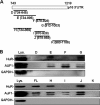HuR uses AUF1 as a cofactor to promote p16INK4 mRNA decay
- PMID: 20498276
- PMCID: PMC2916395
- DOI: 10.1128/MCB.00169-10
HuR uses AUF1 as a cofactor to promote p16INK4 mRNA decay
Abstract
In this study, we show that HuR destabilizes p16(INK4) mRNA. Although the knockdown of HuR or AUF1 increased p16 expression, concomitant AUF1 and HuR knockdown had a much weaker effect. The knockdown of Ago2, a component of the RNA-induced silencing complex (RISC), stabilized p16 mRNA. The knockdown of HuR diminished the association of the p16 3' untranslated region (3'UTR) with AUF1 and vice versa. While the knockdown of HuR or AUF1 reduced the association of Ago2 with the p16 3'UTR, Ago2 knockdown had no influence on HuR or AUF1 binding to the p16 3'UTR. The use of EGFP-p16 chimeric reporter transcripts revealed that p16 mRNA decay depended on a stem-loop structure present in the p16 3'UTR, as HuR and AUF1 destabilized EGFP-derived chimeric transcripts bearing wild-type sequences but not transcripts with mutations in the stem-loop structure. In senescent and HuR-silenced IDH4 human diploid fibroblasts, the EGFP-p16 3'UTR transcript was more stable. Our results suggest that HuR destabilizes p16 mRNA by recruiting the RISC, an effect that depends on the secondary structure of the p16 3'UTR and requires AUF1 as a cofactor.
Figures












Similar articles
-
The tRNA methyltransferase NSun2 stabilizes p16INK⁴ mRNA by methylating the 3'-untranslated region of p16.Nat Commun. 2012 Mar 6;3:712. doi: 10.1038/ncomms1692. Nat Commun. 2012. PMID: 22395603 Free PMC article.
-
Interaction between 3' untranslated region of calcitonin receptor messenger ribonucleic acid (RNA) and adenylate/uridylate (AU)-rich element binding proteins (AU-rich RNA-binding factor 1 and Hu antigen R).Endocrinology. 2004 Apr;145(4):1730-8. doi: 10.1210/en.2003-0862. Epub 2004 Jan 8. Endocrinology. 2004. PMID: 14715706
-
Autotaxin Expression Is Regulated at the Post-transcriptional Level by the RNA-binding Proteins HuR and AUF1.J Biol Chem. 2016 Dec 9;291(50):25823-25836. doi: 10.1074/jbc.M116.756908. Epub 2016 Oct 26. J Biol Chem. 2016. PMID: 27784781 Free PMC article.
-
Increased stability of the p16 mRNA with replicative senescence.EMBO Rep. 2005 Feb;6(2):158-64. doi: 10.1038/sj.embor.7400346. EMBO Rep. 2005. PMID: 15678155 Free PMC article.
-
Hu antigen R and tristetraprolin: counter-regulators of rat apical sodium-dependent bile acid transporter by way of effects on messenger RNA stability.Hepatology. 2011 Oct;54(4):1371-8. doi: 10.1002/hep.24496. Epub 2011 Aug 9. Hepatology. 2011. PMID: 21688286 Free PMC article.
Cited by
-
tRNA-Derived Small RNAs and Their Potential Roles in Cardiac Hypertrophy.Front Pharmacol. 2020 Sep 17;11:572941. doi: 10.3389/fphar.2020.572941. eCollection 2020. Front Pharmacol. 2020. PMID: 33041815 Free PMC article. Review.
-
Regulation of AT1R expression through HuR by insulin.Nucleic Acids Res. 2012 Jul;40(12):5250-61. doi: 10.1093/nar/gks170. Epub 2012 Feb 23. Nucleic Acids Res. 2012. PMID: 22362742 Free PMC article.
-
Coordinated control of senescence by lncRNA and a novel T-box3 co-repressor complex.Elife. 2014 May 29;3:e02805. doi: 10.7554/eLife.02805. Elife. 2014. PMID: 24876127 Free PMC article.
-
NSun2 delays replicative senescence by repressing p27 (KIP1) translation and elevating CDK1 translation.Aging (Albany NY). 2015 Dec;7(12):1143-58. doi: 10.18632/aging.100860. Aging (Albany NY). 2015. PMID: 26687548 Free PMC article.
-
Phosphorylation of poly(rC) binding protein 1 (PCBP1) contributes to stabilization of mu opioid receptor (MOR) mRNA via interaction with AU-rich element RNA-binding protein 1 (AUF1) and poly A binding protein (PABP).Gene. 2017 Jan 20;598:113-130. doi: 10.1016/j.gene.2016.11.003. Epub 2016 Nov 9. Gene. 2017. PMID: 27836661 Free PMC article.
References
-
- Atasoy, U., J. Watson, D. Patel, and J. D. Keene. 1998. ELAV protein HuA (HuR) can redistribute between nucleus and cytoplasm and is upregulated during serum stimulation and T cell activation. J. Cell Sci. 111(Pt 21):3145-3156. - PubMed
-
- Chemnitz, J., D. Pieper, C. Grüttner, and J. Hauber. 2009. Phosphorylation of the HuR ligand APRIL by casein kinase 2 regulates CD83 expression. Eur. J. Immunol. 39:267-279. - PubMed
Publication types
MeSH terms
Substances
LinkOut - more resources
Full Text Sources
Miscellaneous
